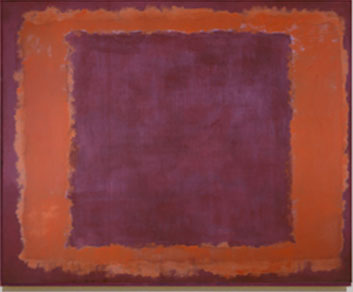

An exhibition at Tate Modern 26th September 2008-1st February 2009
Mark Rothko-a Jewish American artist in New York whose name became a byword for a breakthrough in modern art in the Sixties-I knew the name but had only briefly looked in on the Rothko room at the Tate, retreating in bewilderment, wondering if Abstract Expressionism was anything more than a species of sombre interior decor.
However, entering the much larger room devoted to the series of huge black and maroon canvases in the current exhibition, the effect is arresting, conveying a humbling sense of scale, as if one had tumbled into the crypt of some inner Parthenon. Sitting contemplatively on the suitably minimal benches in the middle of the room, subtle changes of tone and texture reveal themselves as the eye becomes attuned to the layering with fine brush strokes that achieves a mysterious depth of colour.
The series was instigated by a commission in the late Fifties to paint a series of murals for the fashionable Four Seasons restaurant in Mies van der Rohe’s Seagram Building in Manhatten, a setting the painter later deemed inappropriate for the meditative tone of his work. But will this large hall at the Tate which for the duration of the exhibition will inevitably be thronged with passing crowds, provide a more appropriate setting?
The last room displays Rothko’s final series of paintings before he committed suicide: Black on Grey: austere works of varying sizes with dark upper and lighter lower sections; only a faint glimmer of light is discernible on the ‘horizon’-perhaps where masking tape was pulled away to expose a slither of the underlying white gesso primer. These are, according to the accompanying booklet, an exploration of scale and ‘weight’ and it refers elsewhere to the artist’s, ‘meaningful painterly gestures’. It is known that Rothko’s thinking was influenced by Nietsche and Kierkegaard but the meaning of the canvases themselves is obscure and elusive and as his death would seem to testify, brought him little inner illumination. For all that, scrutiny of the monumental maroon and black murals trains the eye. One can emerge from the exhibition in a state of heightened visual perception, ready to receive, through the windows of the Tate, impressions of the subtle greys of the buildings banked against a skyline dominated by St. Paul’s and overarching cranes, animated by fans of ripples from the passing boats below as they ply the grey/green/muddy brown Thames.
http://www.tate.org.uk/modern/exhibitions/markrothko/default.shtm